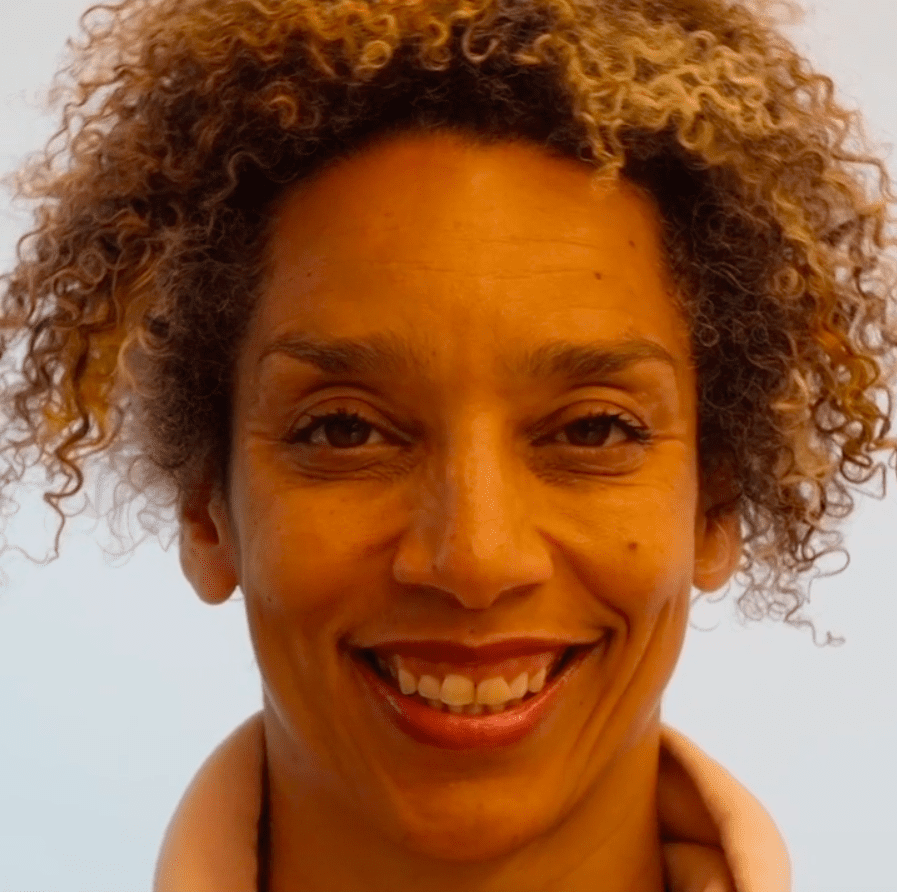an ongoing collaboration
In their latest work, artist/engineer Alexander Reben and dancer/choreographer Alice Sheppard bridge human facial expression and machine learning.
Most ballet and modern dancers are taught not to emote with their faces; a smile being the exception that proves the rule. In other forms and in particular in postmodern movement, the face is a critical expressive tool. As a disabled black woman, I am particularly interested in the face dance from a number of different angles.
I am often told that I have an expressive face, that I don’t have a poker face, and that my face frequently makes me look like an “angry black woman.” Aware of how contemporary conversation has revealed bias in AI, Alex and I wanted to explore how my face is read by Alex’s particular technologies.
The face is a complex expressive canvas for a disabled dancers in general and in particular for me. I often find myself in conversations where the face is described as the perfect form for those of us who move less, for whatever reason. That’s true, but it makes the face a kind of leftover form — something you do when you can’t do anything else. I am known for large athletic movement. In this project, we wanted to ask what is the virtuosity of the face dance?
-Alice Sheppard
If Robots Could Dance | At Home continues a collaboration that Sheppard and Reben began with Pas De Deux, for MAX 2019: A Space Festival, in which her dance interacted with a robotic art-making system he conceptualized that created work live onstage.
The conceptual framework for If Robots Could Dance | At Home stems from Reben’s interactive artwork Latent Face, a photo booth that captured two people’s faces and combined them in latent space. In the new work, AI pulls from a trove of data in latent space to approximate Sheppard’s face between movements.
If Robots Could Dance | At Home transforms the ephemerality of facial expression and forgetting into durational dance. It both challenges the perceived boundaries between the self and the technologies with which it is intertwined, while simultaneously interrogating the limits and biases of the data on which these technologies operate.
—Alexander Reben
Face Preparation
1. Washing
- Before starting, wash your hands and face. Dry, and add moisturizer if your face feels tight or dry
Alice Reflections
There’s something about the temperature of the water as it hits my eyelids and cheeks; I relish it. Refreshing. Experiment with caring for your face softly, stroking the water in with your hands, contrast that with using a soft cloth, and with rubbing with your hands and the cloth. When I’m done, I dry my hands and face softly. I always add moisturizer. It’s intense work, so I like my face to feel as if it can move easily.
2. Loosening
Eyes
- Let’s begin with your eyes closed and working only with your eyeballs.
- Move them softly and slowly around behind your eyelids.
Up, down. Then to the left, right. - Then down in a circle one way. Back the other way.
- Look up to a corner and down to the opposite corner.
- Look up to the other corner and down to the opposite corner.
- Pause with your eyes neutrally in the center.
- Open and close your eyes five times.
Alice Reflections
While doing this, I’m trying to relax my eyes and not see anything in particular. I keep my focus on how my face feels with all this. I often find there are a lot of stiff hard areas when I try the circle and that my eyes move unevenly. This is all fine.
Face
- Rub your hands together to create warmth and place them flat on your face, allowing the heat and sensation to cross over from your hands to your face; hands to face; hands to face.
- Take the middle three fingers of each hand and place them in the center of your forehead. Rub your forehead lightly in circles with your finger tips. Start with both hands close together. Then, move out towards your temples and back in. Then, go down the sides of your jaw and back. Then aross your cheek bones and back. Then, return to your forehead. Slowly, massaging your face.
- Lift your eyebrows up together. Up and down into a frown. Up and down. Several times. Then, try to move them separately. Up and down.
- Wiggle your nose and mouth.
- Stretch your face into a huge smile. Make your face as big as possible and then scrunch it down as small as possible. Again.
- Take both earlobes and pull on them gently. Down and then away from your face. Then, grasping your ears in your hands, move gently them in circles, slowly massaging your face and ears.
Head and Neck
To support this face work, I spend some time relaxing my head and neck.
- Shrug your shoulders to your ears; hold them there for 4 counts; and let them go.
- Nod your head downwards, softly saying yes. 4 times. Breathe out as you go down. Nod your head upwards saying yes to the sky. 4 times. Breathe out as you look up. Swivel your head left and right as if you were scanning the horizon. 4 times.
- Turn your head up to your left and down to your right. Repeat. Turn your head up to your right and down to your left.
- Let your head fall forwards, breathing out; roll your head in a big circle to the right. Let your head fall downwards to your chest, breathing out; roll your head in a big circle to the left.
- Make 4 circles with your shoulders, first forwards and then backwards.
- Shrug your shoulders to your ears; hold them there for 4 counts; and let them go.
- Stretch your arms overhead.
- Cover your head, interlace your fingers, move your shoulders around and bring your arms slowly back to your sides.
Alice Reflections
While moving my head and face, I am always surprised to find how much tension there is in my body. Some of this movement seems so unexpected. Even though it is simple. Sometimes, it feels like I am reckoning with myself.
3. Sitting
- Sit, as still as you can, in a comfortable position for 5 minutes.
- Let your face fall into whatever expressions it falls into. Don’t try to adjust.
Keep your eyes and face soft and relaxed. Your body might move slightly; this is all right.
Alice Reflections
I find this really hard to start. I keep moving. Eventually, I become comfortable. Time falls away; I could do this forever.
Alice Notes
Many of the foundations for this sequence of exercises have come to me from classes with Kitty Lunn and AXIS Dance Company. Some are part of a body of general field practice shared among dancers. I developed this sequence because it prepared me to practice face expressions.
Transformations
We wondered if we could interrogate some of the so-called “bright lines” between humans and artificial intelligences. Building on Alex’s existing work on face transformation and Alice’s work in the tradition of Steve Paxton’s small dance, we created these series of transformations.
An AI can remember and recall, but what does it mean to forget? Can artificial intelligences feel? We wondered what the AI would do with the clearly visible attributes of Alice’s gender and race.
Score for a Face Dance
Emotion, physical feeling, and facial expression all inform each other. For this small face dance, you can play with all three.
Preparation
- Find a mirror or web camera app in which you can see your whole face — you will need it to ensure that you consistently make the same face.
- Find an expression for the following 5 emotions: surprise, happiness, love, gratitude, sadness, hope
To be consistent, I find it helpful to imagine that I am telling a story with my face.
Your gift was such a SURPRISE. I am so HAPPY. I LOVE it and you. THANK YOU. I am SAD we aren’t together. I HOPE we will see each other soon.
When you make your face expression, verify it with your body and your own emotion. Does your body feel happy? Do you feel happy? Do you think you look happy? You can check with someone else or take selfies.
- Practice doing them in sequence. Try to keep the integrity of each expression. You might find that each one is actually a range of expressions with tiny changes. For example, happiness might begin with you starting to smile and last for the period of your smile growing and shrinking.
Need to make changes? There is often a very generative space between the original expression, where you often end up, and something that is not true to your original intent.
Other Elements
- Dances can have speed changes. You can vary how long you stay in each expression and how long it takes you to get to the next one.
- Dances can have music or they can happen in silence. If you like, you can do your dance to music.
Dances can have specific or free-flowing timing. If you want, you can experiment with both. For one possible timing, see the map below. You would spend 3 counts on Surprise and 1 count moving to Happy.
Map

Surprise: 3 / Transition: 1 / Happy: 2 / Transition: 2 / Love: 4 / Transition: 1
Thank you: 2 / Transition: 3 / Sad: 4 / Transition: 2 / Hope: 3


